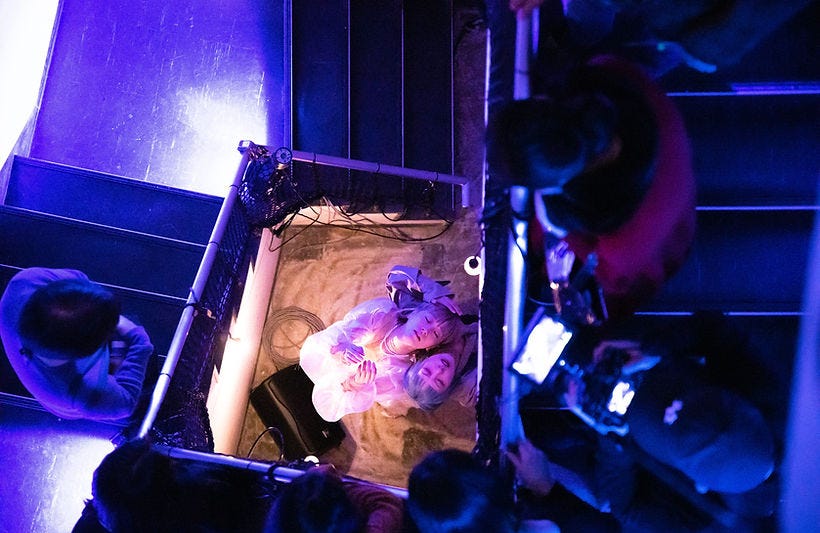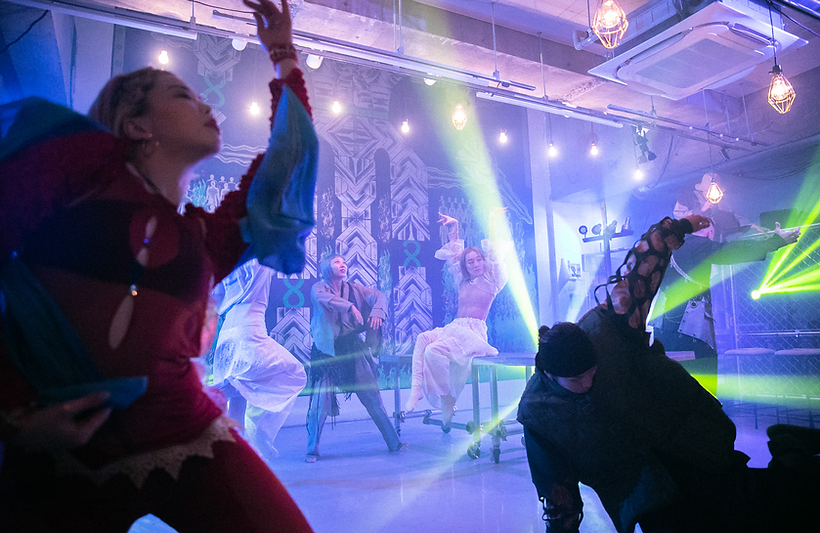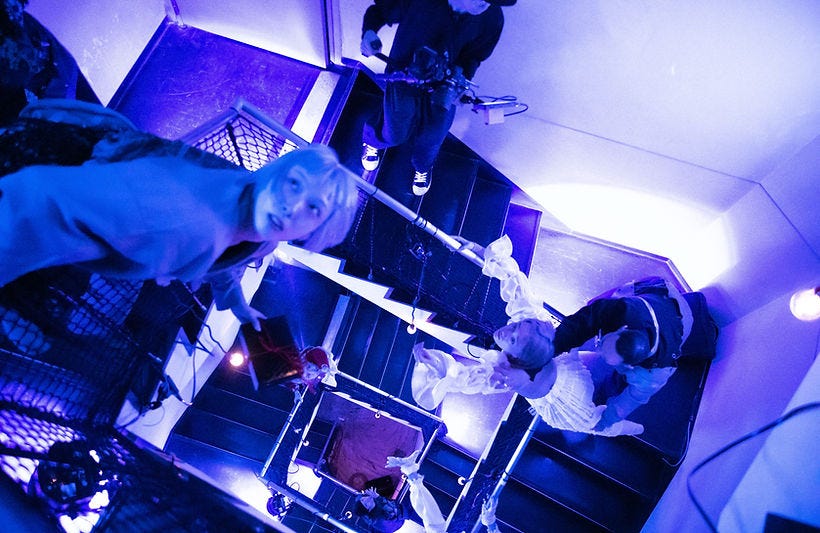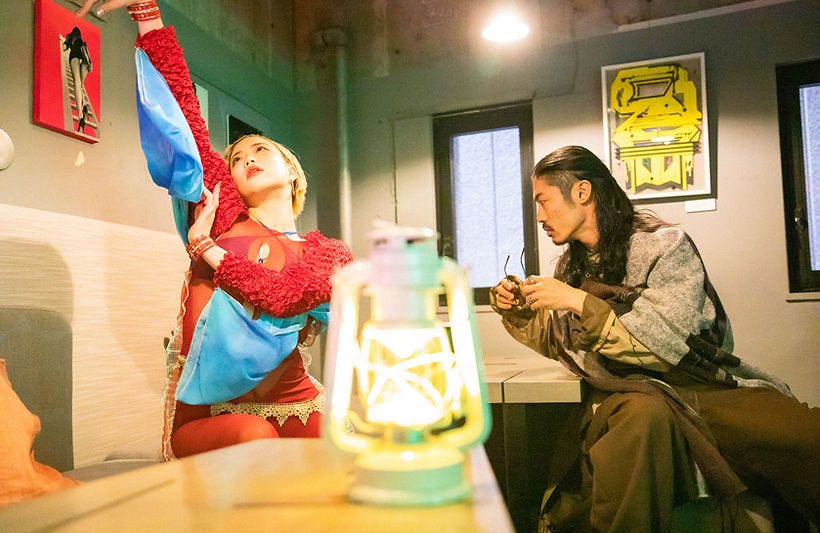
Last December I had the privilege of witnessing Dancing in the Nightmare, a stunning immersive adaptation of the classical Japanese folktale Urashima Taro. The show was a site-specific collaboration with BnA Wall in Tokyo — itself an evolving immersive art installation of a hotel with 26 rooms designed by 14 artists nestled around the eponymous centerpiece; a four-meter tall wall hosting a new mural every three months. The show was a beautiful mosaic; a bespoke mystery making the most of the unique spaces afforded by the hotel.
After the show, I spoke with Daisydoze artistic director Yui Takeshima about some of the challenges facing the up-and-coming theater group as they strive towards a truly borderless experience, one that can transcend language by speaking to the dream life of the collective unconscious. But borderless here means more than just transcending language and culture. Daisydoze (formerly Dramatic Dining) also strives to erase the boundaries between the mundane and the intuitive, the audience and the performance, and the experience of the show and the environment in which it takes place. This vision of a truly immersive universal theatrical experience is as ambitious as it is challenging. Culture runs deep, and uncovering and expressing the underlying human commonplaces requires innovative tools and techniques adapted from a variety of domains.

While innovation is never easy, this is especially true in conservative Japan, where categories tend to be rigid, change is greeted with extreme caution, and people want to be clear on their roles so they can understand how to behave appropriately. This stance poses special barriers to a theater company striving to create a culture-transcending experience.
One of the biggest hurdles any fledgling theater company faces is financing. Ms. Takeshima tells me that the group has been refused grants because their vision didn’t match the rigid governmental definition of theater; a performance taking place in a designated space in which the audience sits and passively watches actors on a stage perform a story with a clear beginning, middle, and end.
Daisydoze instead takes the individual members of the audience on a personal journey; the elements of the story are revealed like pieces of a puzzle to be pondered; lingering fragments of a shared and ancient dream told primarily in non-verbal narrative.
Not exactly the neatly categorized package that the grant granters scramble to support.
This lack of understanding posed an obstacle, not just in terms of government support but also in the much-needed status that recognition affords.
This issue with categorization has been larger than just dealing with bureaucracy though.
Immersive creators around the world are faced with the challenge of meeting, subverting, or managing audience expectations. Audiences have expectations about what a dance performance should look like. The same with straight plays and art installations. And they want to have those expectations met. In Japan, where propriety is paramount, people feel compelled to know what they are getting into. They want to understand whether the show is correct or not, and to be sure that they are behaving appropriately in the context of the performance.

This runs counter to Daisydoze’s novel approach to storytelling which deliberately removes the audience from ordinary reality with radically deconstructed elements presented to individuals and small groups in novel settings by street dancers, an intentionally enigmatic tactic designed to reorient the audience to the dreamy reality in which the free-floating elements of the myth can take on a deeper personal resonance.
Daisydoze consistently sells shows out now, but winning an audience hasn’t been easy. “People were telling us that they really enjoyed the dancing but couldn’t understand the deeper meaning behind it,” Ms. Takeshima says. One substantial source of support has come from her connections in the advertising and creative spheres “People in both of these fields are always looking for something unique and original, and they are ready and willing to embrace a new experience.”
Get Benjamin Beardsley’s stories in your inbox
Join Medium for free to get updates from this writer.
SubscribeSubscribe
In order to seduce the audience into the dream world of the show, the group implements what they call a mindset strategy. It goes something like this:
At the door, guests are asked to check their coats and bags — a subliminal suggestion to leave behind the mundane and surrender to the world of the show.
Next, they’re asked to sign a simple release on their way to the cozy, chic bar overlooking the atrium showcasing the hotel’s impressive mural wall. Two colorful kinds of shots grace the bar, labeled “Hypnosis” and “Discover”, they entice the audience like something from Alice in Wonderland.
After a short wait, each member is individually invited to explore a room, the number of which has been printed on their ticket. Alone in the room they take in clues in the ephemeral set dressing. Something has happened or will happen, and as in a dream, the senses dilate as the search for meaning begins.

One by one they find the clue that leads them to the basement level of the atrium beneath the mural — one of the few times during the show that they gather into a single audience. A guided meditation plays on speakers, leading them even deeper into the dream.
The guided meditation, adapted from a US Navy sleep protocol, transitions seamlessly into a dance vignette. The audience is seamlessly transported into the realm of the collective unconscious, immersed in the watery world of the play, a profoundly personal experience that continues to unfold as the members are individually guided through the rooms and spaces of the exquisitely utilized BnA Wall.
All of these elements are carefully calculated to break the audience out of the trance of daily life and open them fully to the fantastic world of the show. While the performance is entirely non-verbal, in the transitions between spaces cards are provided with text in English and Japanese.
That their shows have begun selling out despite their novelty is a testimony to both the efficacy of the strategy and the quality of their work.

All great plays express profound insights into the human condition, and Dancing the Nightmare was no exception. It was a rich and unique exploration of desires and cravings that live in the unconscious mind; themes of love and loss and longing for home beautifully and succinctly expressed with a unique modern Japanese aesthetic. It was exceptional in the way it pulled me in and revealed areas of my own unconscious fears and longings without recourse to words. At the same time, it deftly transcended the novelty of immersive art by transforming spaces into living elements of story.
Being on the cutting edge of culture has its drawbacks. Without international prestige, it’s not easy to gain acceptance for something new here. That’s why Ms. Takeshima and her partner, Art Director Kaori Kondo share the hope that creating a truly borderless experience will attract an international audience which will help raise the legitimacy of immersive theater as a genre in Japan “…as Ukiyoe became so popular after French people discovered its beauty, as Haruki Murakami, Yayoi Kusama got popular in the States first and came into Japan by reverse import.”
Daisydoze’s next show will take place in the same venue as above (BnA Wall in Tokyo) in December of 2023. The company can be followed on Instagram.
Discover the latest immersive events, festivals, workshops, and more at our new site EVERYTHING IMMERSIVE, new home of NoPro’s show listings.
NoPro is a labor of love made possible by our generous Patreon backers. Join them today!
In addition to the No Proscenium website, our podcast, and our newsletters, you can find NoPro on Facebook, LinkedIn,YouTube, Twitter, Instagram, in the Facebook community Everything Immersive, and on our Patreon Backer exclusive Discord.


















Discussion